2008 PONTIAC GRAND PRIX Tire pressure
[x] Cancel search: Tire pressurePage 239 of 450
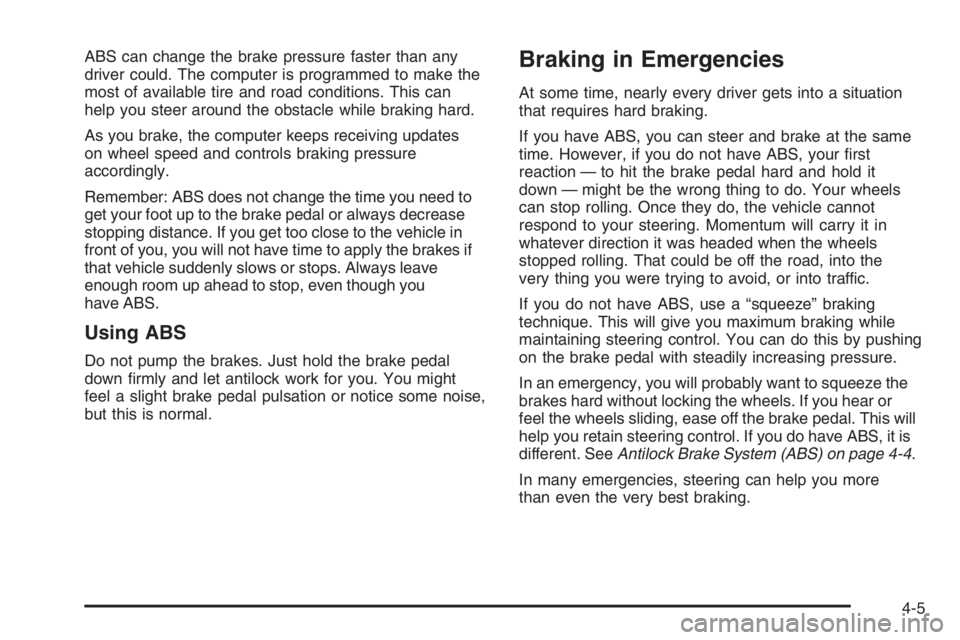
ABS can change the brake pressure faster than any
driver could. The computer is programmed to make the
most of available tire and road conditions. This can
help you steer around the obstacle while braking hard.
As you brake, the computer keeps receiving updates
on wheel speed and controls braking pressure
accordingly.
Remember: ABS does not change the time you need to
get your foot up to the brake pedal or always decrease
stopping distance. If you get too close to the vehicle in
front of you, you will not have time to apply the brakes if
that vehicle suddenly slows or stops. Always leave
enough room up ahead to stop, even though you
have ABS.
Using ABS
Do not pump the brakes. Just hold the brake pedal
down �rmly and let antilock work for you. You might
feel a slight brake pedal pulsation or notice some noise,
but this is normal.
Braking in Emergencies
At some time, nearly every driver gets into a situation
that requires hard braking.
If you have ABS, you can steer and brake at the same
time. However, if you do not have ABS, your �rst
reaction — to hit the brake pedal hard and hold it
down — might be the wrong thing to do. Your wheels
can stop rolling. Once they do, the vehicle cannot
respond to your steering. Momentum will carry it in
whatever direction it was headed when the wheels
stopped rolling. That could be off the road, into the
very thing you were trying to avoid, or into traffic.
If you do not have ABS, use a “squeeze” braking
technique. This will give you maximum braking while
maintaining steering control. You can do this by pushing
on the brake pedal with steadily increasing pressure.
In an emergency, you will probably want to squeeze the
brakes hard without locking the wheels. If you hear or
feel the wheels sliding, ease off the brake pedal. This will
help you retain steering control. If you do have ABS, it is
different. SeeAntilock Brake System (ABS) on page 4-4.
In many emergencies, steering can help you more
than even the very best braking.
4-5
Page 247 of 450
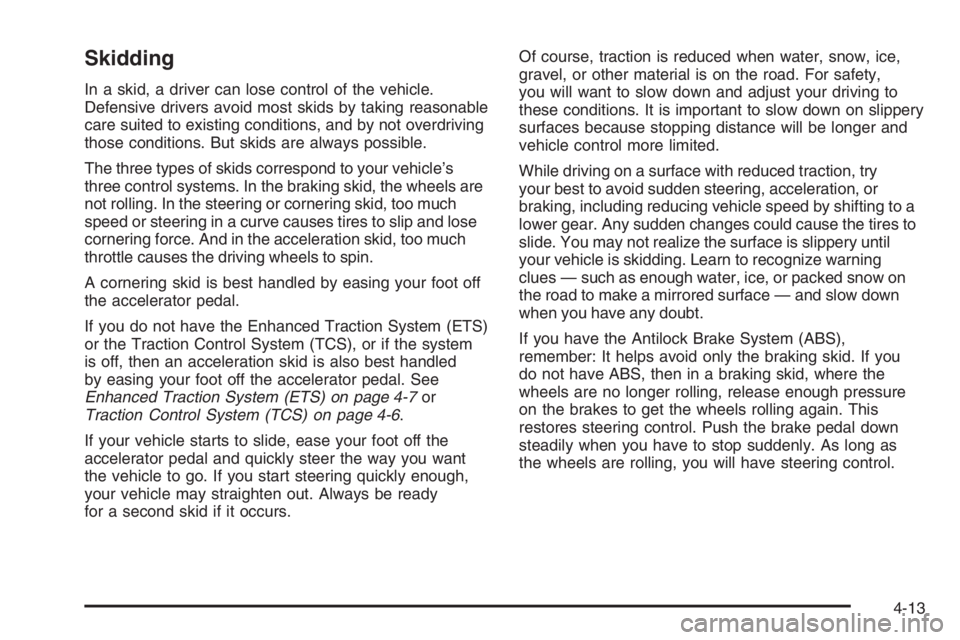
Skidding
In a skid, a driver can lose control of the vehicle.
Defensive drivers avoid most skids by taking reasonable
care suited to existing conditions, and by not overdriving
those conditions. But skids are always possible.
The three types of skids correspond to your vehicle’s
three control systems. In the braking skid, the wheels are
not rolling. In the steering or cornering skid, too much
speed or steering in a curve causes tires to slip and lose
cornering force. And in the acceleration skid, too much
throttle causes the driving wheels to spin.
A cornering skid is best handled by easing your foot off
the accelerator pedal.
If you do not have the Enhanced Traction System (ETS)
or the Traction Control System (TCS), or if the system
is off, then an acceleration skid is also best handled
by easing your foot off the accelerator pedal. See
Enhanced Traction System (ETS) on page 4-7or
Traction Control System (TCS) on page 4-6.
If your vehicle starts to slide, ease your foot off the
accelerator pedal and quickly steer the way you want
the vehicle to go. If you start steering quickly enough,
your vehicle may straighten out. Always be ready
for a second skid if it occurs.Of course, traction is reduced when water, snow, ice,
gravel, or other material is on the road. For safety,
you will want to slow down and adjust your driving to
these conditions. It is important to slow down on slippery
surfaces because stopping distance will be longer and
vehicle control more limited.
While driving on a surface with reduced traction, try
your best to avoid sudden steering, acceleration, or
braking, including reducing vehicle speed by shifting to a
lower gear. Any sudden changes could cause the tires to
slide. You may not realize the surface is slippery until
your vehicle is skidding. Learn to recognize warning
clues — such as enough water, ice, or packed snow on
the road to make a mirrored surface — and slow down
when you have any doubt.
If you have the Antilock Brake System (ABS),
remember: It helps avoid only the braking skid. If you
do not have ABS, then in a braking skid, where the
wheels are no longer rolling, release enough pressure
on the brakes to get the wheels rolling again. This
restores steering control. Push the brake pedal down
steadily when you have to stop suddenly. As long as
the wheels are rolling, you will have steering control.
4-13
Page 249 of 450

Hydroplaning
Hydroplaning is dangerous. Water can build up
under your vehicle’s tires so they actually ride on the
water. This can happen if the road is wet enough
and you are going fast enough. When your vehicle is
hydroplaning, it has little or no contact with the road.
There is no hard and fast rule about hydroplaning.
The best advice is to slow down when the road is wet.
Other Rainy Weather Tips
Besides slowing down, other wet weather driving
tips include:
Allow extra following distance.
Pass with caution.
Keep windshield wiping equipment in good shape.
Keep the windshield washer �uid reservoir �lled.
Have good tires with proper tread depth.
SeeTires on page 5-62.
Before Leaving on a Long Trip
To prepare your vehicle for a long trip, consider having
it serviced by your dealer/retailer before departing.
Things to check on your own include:
Windshield Washer Fluid:Reservoir full?
Windows clean — inside and outside?
Wiper Blades:In good shape?
Fuel, Engine Oil, Other Fluids:All levels checked?
Lamps:Do they all work and are lenses clean?
Tires:Are treads good? Are tires in�ated to
recommended pressure?
Weather and Maps:Safe to travel?
Have up-to-date maps?
4-15
Page 257 of 450
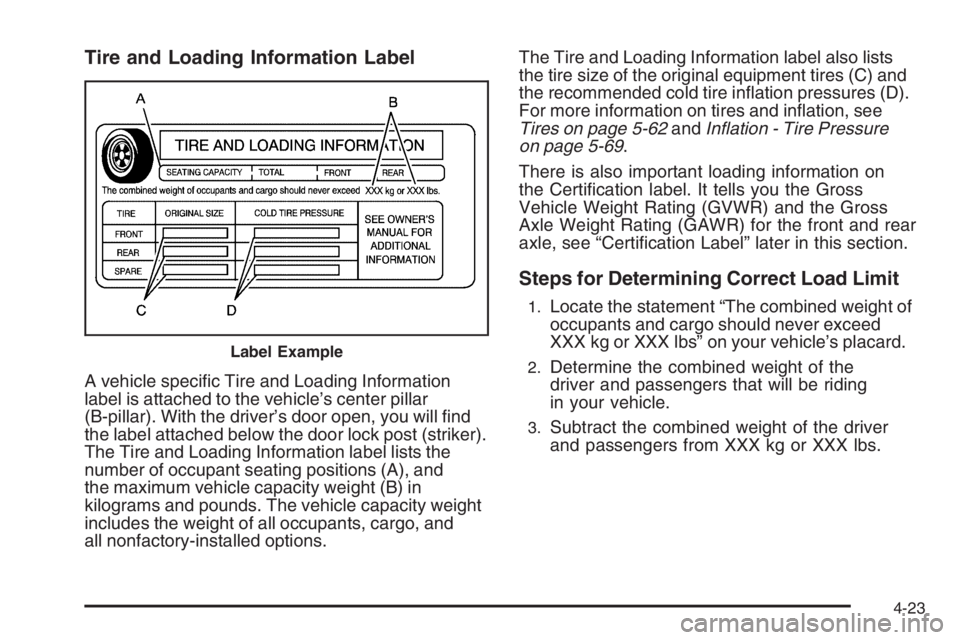
Tire and Loading Information Label
A vehicle speci�c Tire and Loading Information
label is attached to the vehicle’s center pillar
(B-pillar). With the driver’s door open, you will �nd
the label attached below the door lock post (striker).
The Tire and Loading Information label lists the
number of occupant seating positions (A), and
the maximum vehicle capacity weight (B) in
kilograms and pounds. The vehicle capacity weight
includes the weight of all occupants, cargo, and
all nonfactory-installed options.The Tire and Loading Information label also lists
the tire size of the original equipment tires (C) and
the recommended cold tire in�ation pressures (D).
For more information on tires and in�ation, see
Tires on page 5-62andInflation - Tire Pressure
on page 5-69.
There is also important loading information on
the Certi�cation label. It tells you the Gross
Vehicle Weight Rating (GVWR) and the Gross
Axle Weight Rating (GAWR) for the front and rear
axle, see “Certi�cation Label” later in this section.
Steps for Determining Correct Load Limit
1.Locate the statement “The combined weight of
occupants and cargo should never exceed
XXX kg or XXX lbs” on your vehicle’s placard.
2.Determine the combined weight of the
driver and passengers that will be riding
in your vehicle.
3.Subtract the combined weight of the driver
and passengers from XXX kg or XXX lbs.
Label Example
4-23
Page 267 of 450
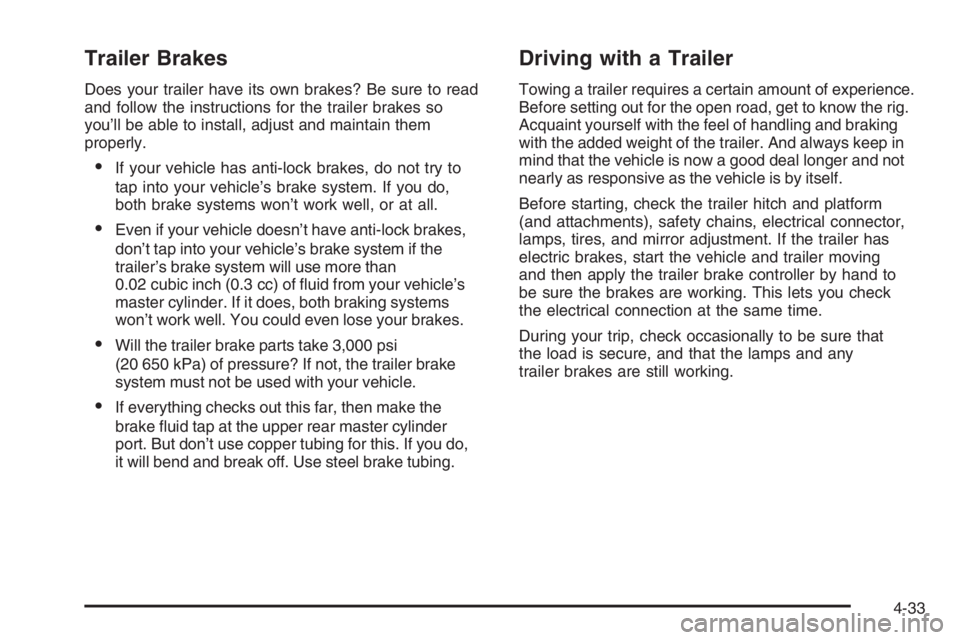
Trailer Brakes
Does your trailer have its own brakes? Be sure to read
and follow the instructions for the trailer brakes so
you’ll be able to install, adjust and maintain them
properly.
If your vehicle has anti-lock brakes, do not try to
tap into your vehicle’s brake system. If you do,
both brake systems won’t work well, or at all.
Even if your vehicle doesn’t have anti-lock brakes,
don’t tap into your vehicle’s brake system if the
trailer’s brake system will use more than
0.02 cubic inch (0.3 cc) of �uid from your vehicle’s
master cylinder. If it does, both braking systems
won’t work well. You could even lose your brakes.
Will the trailer brake parts take 3,000 psi
(20 650 kPa) of pressure? If not, the trailer brake
system must not be used with your vehicle.
If everything checks out this far, then make the
brake �uid tap at the upper rear master cylinder
port. But don’t use copper tubing for this. If you do,
it will bend and break off. Use steel brake tubing.
Driving with a Trailer
Towing a trailer requires a certain amount of experience.
Before setting out for the open road, get to know the rig.
Acquaint yourself with the feel of handling and braking
with the added weight of the trailer. And always keep in
mind that the vehicle is now a good deal longer and not
nearly as responsive as the vehicle is by itself.
Before starting, check the trailer hitch and platform
(and attachments), safety chains, electrical connector,
lamps, tires, and mirror adjustment. If the trailer has
electric brakes, start the vehicle and trailer moving
and then apply the trailer brake controller by hand to
be sure the brakes are working. This lets you check
the electrical connection at the same time.
During your trip, check occasionally to be sure that
the load is secure, and that the lamps and any
trailer brakes are still working.
4-33
Page 271 of 450

Service............................................................5-3
Accessories and Modi�cations..........................5-3
California Proposition 65 Warning.....................5-3
California Perchlorate Materials Requirements.....5-4
Doing Your Own Service Work.........................5-4
Adding Equipment to the Outside of Your
Vehicle......................................................5-5
Fuel................................................................5-5
Gasoline Octane............................................5-5
Gasoline Speci�cations....................................5-6
California Fuel...............................................5-6
Additives.......................................................5-6
Fuels in Foreign Countries...............................5-7
Filling the Tank..............................................5-8
Filling a Portable Fuel Container.....................5-10
Checking Things Under the Hood....................5-10
Hood Release..............................................5-11
Engine Compartment Overview.......................5-12
Engine Oil...................................................5-15
Engine Oil Life System..................................5-18
Engine Air Cleaner/Filter................................5-20
Automatic Transmission Fluid.........................5-22
Engine Coolant.............................................5-24
Pressure Cap...............................................5-27
Engine Overheating.......................................5-27Overheated Engine Protection
Operating Mode........................................5-29
Cooling System............................................5-30
Power Steering Fluid.....................................5-39
Windshield Washer Fluid................................5-40
Brakes........................................................5-41
Battery........................................................5-45
Jump Starting...............................................5-46
Headlamp Aiming...........................................5-51
Bulb Replacement..........................................5-54
Halogen Bulbs..............................................5-54
Headlamps and Sidemarker Lamps.................5-54
Front Turn Signal, Parking and Fog Lamps......5-57
Taillamps, Turn Signal, and Stoplamps............5-58
Back-Up Lamps............................................5-59
License Plate Lamp......................................5-60
Replacement Bulbs.......................................5-60
Windshield Replacement.................................5-61
Windshield Wiper Blade Replacement..............5-61
Tires..............................................................5-62
Tire Sidewall Labeling...................................5-63
Tire Terminology and De�nitions.....................5-66
In�ation - Tire Pressure.................................5-69
Tire Pressure Monitor System.........................5-71
Section 5 Service and Appearance Care
5-1
Page 272 of 450

Tire Pressure Monitor Operation.....................5-72
Tire Inspection and Rotation...........................5-75
When It Is Time for New Tires.......................5-77
Buying New Tires.........................................5-78
Different Size Tires and Wheels......................5-80
Uniform Tire Quality Grading..........................5-80
Wheel Alignment and Tire Balance..................5-82
Wheel Replacement......................................5-82
Tire Chains..................................................5-84
If a Tire Goes Flat........................................5-85
Tire Sealant and Compressor Kit (GXP)...........5-86
Changing a Flat Tire.....................................5-96
Removing the Spare Tire and Tools................5-98
Removing the Flat Tire and Installing the
Spare Tire..............................................5-100
Storing a Flat or Spare Tire and Tools...........5-107
Compact Spare Tire....................................5-109
Appearance Care..........................................5-109
Interior Cleaning.........................................5-109
Fabric/Carpet..............................................5-111
Leather......................................................5-112
Ultra Lux Suede..........................................5-113
Instrument Panel, Vinyl, and Other Plastic
Surfaces.................................................5-113
Care of Safety Belts....................................5-114Weatherstrips.............................................5-114
Washing Your Vehicle..................................5-114
Cleaning Exterior Lamps/Lenses....................5-115
Finish Care................................................5-115
Windshield and Wiper Blades.......................5-116
Aluminum Wheels.......................................5-116
Tires.........................................................5-117
Sheet Metal Damage...................................5-117
Finish Damage...........................................5-117
Underbody Maintenance...............................5-117
Chemical Paint Spotting...............................5-118
Vehicle Care/Appearance Materials................5-118
Vehicle Identi�cation.....................................5-119
Vehicle Identi�cation Number (VIN)................5-119
Service Parts Identi�cation Label...................5-120
Electrical System..........................................5-120
Add-On Electrical Equipment.........................5-120
Headlamp Wiring........................................5-120
Windshield Wiper Fuses...............................5-121
Power Windows and Other Power Options......5-121
Fuses and Circuit Breakers..........................5-121
Instrument Panel Fuse Block........................5-122
Underhood Fuse Block................................5-124
Capacities and Speci�cations........................5-128
Section 5 Service and Appearance Care
5-2
Page 332 of 450
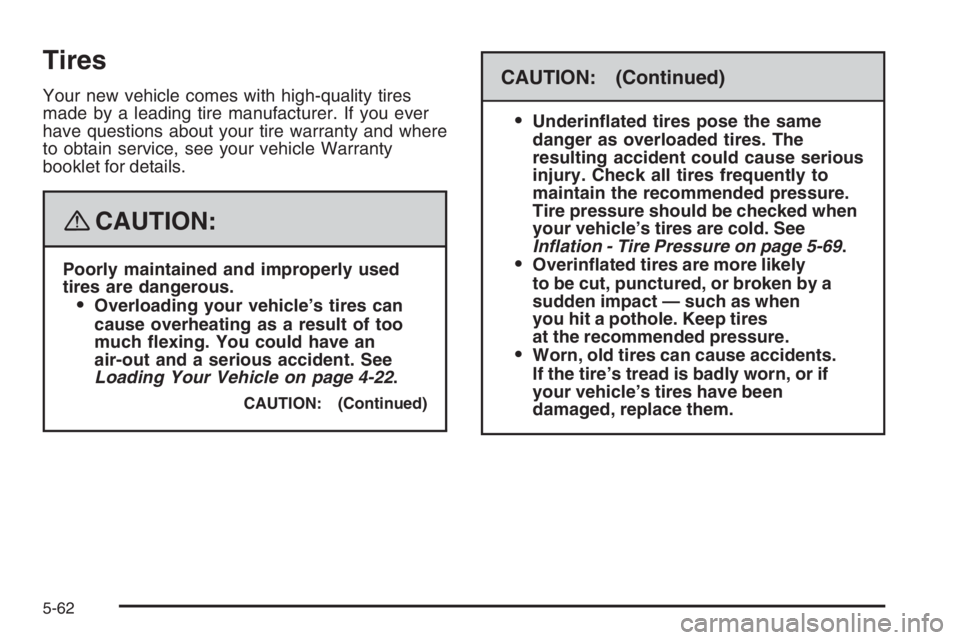
Tires
Your new vehicle comes with high-quality tires
made by a leading tire manufacturer. If you ever
have questions about your tire warranty and where
to obtain service, see your vehicle Warranty
booklet for details.
{CAUTION:
Poorly maintained and improperly used
tires are dangerous.
Overloading your vehicle’s tires can
cause overheating as a result of too
much �exing. You could have an
air-out and a serious accident. See
Loading Your Vehicle on page 4-22.
CAUTION: (Continued)
CAUTION: (Continued)
Underin�ated tires pose the same
danger as overloaded tires. The
resulting accident could cause serious
injury. Check all tires frequently to
maintain the recommended pressure.
Tire pressure should be checked when
your vehicle’s tires are cold. See
Inflation - Tire Pressure on page 5-69.
Overin�ated tires are more likely
to be cut, punctured, or broken by a
sudden impact — such as when
you hit a pothole. Keep tires
at the recommended pressure.
Worn, old tires can cause accidents.
If the tire’s tread is badly worn, or if
your vehicle’s tires have been
damaged, replace them.
5-62